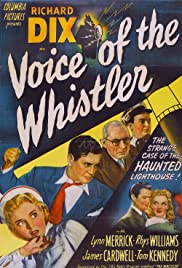
VOICE OF THE WHISTLER
US, 1945, 60 minutes, Black-and-white.
Richard Dix, Lynn Merrick, Rhys Williams, James Cardwell, Tom Kennedy.
Directed by William Castle.
The Whistler was originally a radio program on CBS, from 1942 to 1955.
A series of eight films began in 1944, small supporting features at Columbia. Four of the films were directed by William Castle who, during the 1950s, directed small budget action adventures like Slaves of Babylon, Saracen Blade. From 1958 to 1968 he made a number of exploitative horror films with all kinds of gimmicks to scare audiences, House on Haunted Hill, I Saw What you Did. He also produced Rosemary’s Baby.
• The Whistler - 1944, directed by William Castle
• The Mark of the Whistler - 1944, directed by William Castle
• The Power of the Whistler – 1945, directed by Lew Landers
• Voice of the Whistler – 1945, directed by William Castle
• Mysterious Intruder – 1946, directed by William Castle
• The Secret of the Whistler – 1946, directed by George Sherman
• The Thirteenth Hour – 1947, directed by William Clemens
• The Return of the Whistler – 1948, directed by D. Ross Lederman
As with the radio program, the films are introduced by a shadowy figure walking across the screen, with his signature whistling, which sometimes recurs throughout the film is. He begins to speak, is a narrator of stories about crime, sometimes intervening with narration during the action of the films.
The star of seven of the eight of the films was Richard Dix who had begun his silent film career in 1917, was a popular star for the next 30 years, appearing in the 1931 Academy Award winning Cimarron.
The interesting point about Richard Dix’s presence is that he portrayed a different character in each film. Most of the characters are not entirely sympathetic, ambiguous in their moral attitudes, sometimes swinging between the law and working outside the law.
This is the fourth in the series of Columbia Studios Whistler series. It was directed by William Castle, who directed another three of the films.
This one is more intriguing than most. Once again, Richard Dix portrays an ambiguous character on both sides of the law. He is John Sinclair, a millionaire by 1938 – with the opening of the film tracing back his service in the war, his business acumen, his building up an empire, but with a growing moodiness and dissatisfaction. He is recommended to take a vocation, a cruise on the Great Lakes.
He travels by train, meets a very friendly Welshman driving the cab, Ernie Sparrow, a former British boxing champion, a sympathetic performance from Rhys Williams, but collapses and is taken to a clinic where he also meets a sympathetic nurse, Joan, played by Lynn Merrick. She has been engaged for some years to a medical student, Fred. Sinclair falsifies his name to John Carter and agrees to stay with Ernie.
Ernie is a very genial character, kindly to everyone he meets. He makes such a good impression on Sinclair that he decides to go for the cruise, offering to take Ernie as a companion and inviting Joan.
The film opens with Joan, alone on an island in the lighthouse so we know there is going to be something sinister. She has become impatient with the long engagement to Fred though she loves him. She is also dissatisfied with her job and wants finance for a comfortable life. John proposes that she marry him just as a contract, the remaining six months of his life.
The consequences are different from what was expected. She becomes bored and lonely. He falls in love with her. Then Fred arrives, wanting to take Joan away. There are emotional clashes – with Ernie as a peacemaking go-between.
There is a further twist with John explaining to Fred how a perfect murder could be achieved at the lighthouse. Friend decides to follow through and urges Ernie to get locks for all the windows. However, this is John’s plan to murder Ernie, spikes Fred’s drink, trigger Fred into thinking that he was murdering John in bed, but it was only bedding. John then kills Fred and plans to throw his body out the window onto the cliffs below – but finds that the windows have all been nailed up by Ernie.
John carries the body down to the sea but is found out by both John and Ernie, concocting a story that neither believe. With John’s death, Joan remains lonely and isolated at the lighthouse.
Certainly one of the more unexpected screenplays in the series.